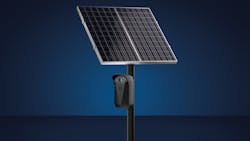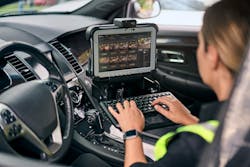Keeping an Eye on Traffic with Automatic License Plate Readers
As law enforcement agencies and the communities they serve continue to try to do more with less, technology can help free up valuable resources while capturing important data that can be used to keep roadways safer.
This article appeared in the January/February issue of OFFICER Magazine. Click Here to view the digital edition. Click Here to subscribe to OFFICER Magazine.
OFFICER Magazine recently spoke with Nathan Maloney from Leonardo ELSAG and Larry Legere, Commercial Director for AutoVu at Genetec, about how Automatic License Plate Readers (ALPR) have evolved.
Keeping traffic moving
Law enforcement officers on patrol are the most familiar with mobile ALPR units that can be mounted on a cruiser in order to look up vehicle license plates while on patrol. Fixed ALPR, which are placed on poles or buildings overlooking roads, collect and store data that can be used to pinpoint problem areas and also be used in real time.
“Some of the things we’re doing from a fixed perspective, beyond just the criminal aspect, there are some aspects looking at how much through traffic there is, time of travel, looking to see if the time of travel is being extended or shortened,” says Legere. “A lot of times that could give some insight in regard to if the normal travel time is 30 minutes between A and B and it’s now an hour, there is possibly an accident or some event happening that is causing that delay.”
Legere added that while law enforcement often focuses on the criminal aspect of ALPR, what a lot of people don’t realize is that from a mobile parking perspective, there is a big safety component. “The National Safety Council always talks about how there are 50,000 accidents in parking lots from vehicles, but not a lot of people realize that a lot of this issue actually goes to the roadways,” he says, noting that once parking space occupancy is in the high 90s, crashes involving vehicles and pedestrians increase. “That parking space becomes so valuable that people are willing to make a U-turn in the middle of the street and erratic movements just to be able to get that spot.”
Maloney says that ALPR can be used to alleviate traffic congestion, as well as main street parking. “We can do time-enforced parking to keep traffic moving so you don’t have someone sitting in front of the bakery for 8 hours a day. That’s an area where we can improve traffic flow,” he says, adding that frictionless parking, where a license plate is automatically added to a list to give access, can also help keep traffic moving. “Allowing them in areas or in the garages or other facilities really keeps things at an even pace rather than having to wait for someone to issue a pass or a ticket.”Advances in ALPR
Legere says that ALPR systems have gone beyond the license plate and have become more vehicle centric. The unit acts as more of a sensor that can recognize the vehicle color, height and classification. “It knows the difference between a car, a truck, a bus, and this helps from a standpoint of traffic where we are looking at ways to utilize the software,” he says. “Is a car in the bus lane? Are the trucks that are not supposed to be in the left lane? Regardless of the license plate we can tell you that a truck is in the left lane that isn’t supposed to be in the left lane.”
Maloney says that other analytical features such as convoy analysis can help in investigation. “We’re looking at patterns of vehicles that are traveling together or maybe parked together,” he says. “They can be up to suspicious activity if the pattern is highly repetitive."
Keeping officers safe
ALPR gives officers the upper hand at traffic stops. Before they exit their vehicles, they are able to match more information to determine if there is any other information they should know before approaching. “They know more information, which allows them to prepare for the situation a lot better, which improves safety,” says Legere. “The more insight you have, the more you can prepare for it.”
As a unified solution, ALPR can be used alongside video and other analytics to provide insight to understand predictively what is going to happen or what may happen at certain times of the day in certain situations. “That all comes from the data,” he says. “Without the data, time to do that predetermination of what’s going to happen, and you just need to correlate traffic flow with weather patterns, you can now determine, based on a weather front coming in that there is a certain amount of rain based on a certain area and the feasibility of flooding coming into that area. The more data we’re gathering, allows us to make decisions and adapt.”The future of ALPR
Legere believes ALPR will trend towards collecting more vehicle characteristics in the future. “The more information we can determine from the vehicle—size, shape, the color, the classification—will allow us to do better investigations from a larger standpoint, but also traffic control from a safety perspective to make sure certain vehicles are staying in certain lanes so that the bus lane stays open, which allows for better flow of traffic and people. I think that the insights coming from deep learning will allow us to continue improving the analytics, which gives better quality data.”
He says that a lot of the ALPR is now starting to turn toward solar as well as the ability to process the data in the cloud in order to generate lower consumption in the field. “We went from a device that was drawing 35 to 40 watts to a device that draws less than 5 watts. This allows us to place these types of devices without that infrastructure so it’s easy to move it, it’s easy to put it in, it’s easy to do a traffic study,” he says. “It’s just a lot of flexibility. It all started because of the ability to move the analytics or a hybrid aspect of capturing some data in the field and taking that data or those images and information, sending it to a cloud processing to do the heavy lifting on the analytics in the cloud. It allowed us to build more technology that was more solar ready, which allows for a lot more flexibility on deployment.”
This article appeared in the January/February issue of OFFICER Magazine.
About the Author
Paul Peluso
Editor
Paul Peluso is the Managing Editor of OFFICER Magazine and has been with the Officer Media Group since 2006. He began as an Associate Editor, writing and editing content for Officer.com. Previously, Paul worked as a reporter for several newspapers in the suburbs of Baltimore, MD.




